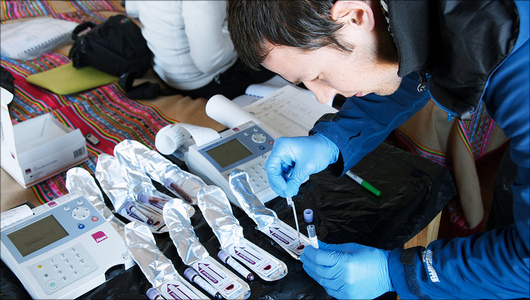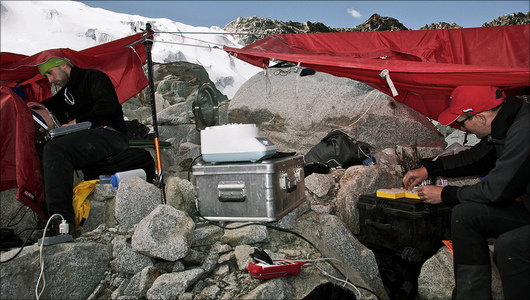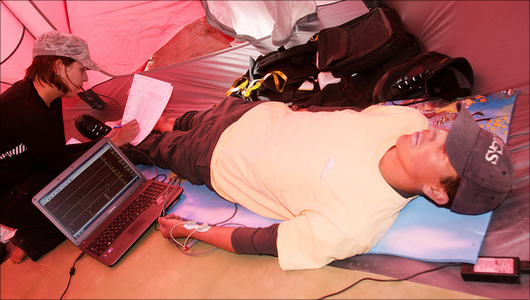High Altitude Research Study - June 2012

High altitude research provides a way of provoking profound physiological changes in a group of subjects and provides an interesting insight into hypoxia and mechanisms of adapatation to hypoxia. The military uses the outdoor environment to develop individuals through "adventurous training" aiming to develop new, transferrable skills and prepare individuals for the rigours of deployment. This leads to obvious synergy and has enabled Surgeon Commander Adrian Mellor to conduct four field studies during the course of high altitude expeditions, carrying out some interesting and thought provoking research whilst engaging in his passion for mountaineering. He recounts his latest and most ambitious experience below:
My most recent project took place during May and June 2012 to the Cordillera Real area of Bolivia. Subjects (a total of 50 in two teams) were selected from across the Defence Medical Services consisting of doctors, nurses, physios, mental health nurses and medical assistants. All came along as willing volunteers and keen to experience some mountaineering. To achieve this the trip was split into two phases, 10 days of field study and 10 days of climbing which allowed full focus on the research. During the build up to the study I was fortunate in receiving military support for an MD at Newcastle University, in the hormonal adaptation to acute and chronic hypoxia, which gave me the time and focus for such a trip.

One of the difficulties of field research at high altitude is that the investigators are under the same physiological stress as the subjects (and often a lot more self induced emotional stress). To try to mitigate against this we had prepared several of the expedition team as investigators, as well as providing a larger pool of manpower it also gave the trainee doctors on the trip valuable experience in research. I also arrived in Bolivia two days ahead of the team giving myself some time to start acclimatizing before starting the data collection. Flying into La Paz at 3800m is a significant challenge, oxygen saturations fall to the mid 80's and sleep is disturbed for the first few nights.
The research profile gave us days for study during the course of a sensible acclimatization profile. Studies were performed at 3800m, 4400m and 5200m and in environments becoming more austere. At 3800m we were in a large hotel room with plentiful power supply, 4400m in a drafty barn and 5200m sitting on granite blocks on the edge of a glacier relying on a generator (fortunately the sun shone and the generator behaved). Whilst this environment was stunning in terms of scenery, the challenge of moving the team and equipment over several hours and 500m of steep scree and then getting straight down to the research protocol, whilst ones own saturations are in the mid 70's cannot be underestimated!
During the course of the 10 days research we collected 2500 cryovials of serum, 300 cardiac echo studies, 300 urine samples and 600 salivary samples. All these had to be frozen and maintained in that state for the duration of the expedition and transport back to the UK. Fortunately we had a willing and strong team of local porters to move the several hundred kilos of research paraphernalia.








